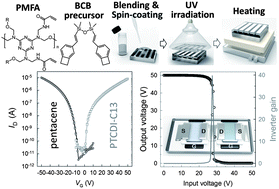Complementary photo and temperature cured polymer dielectrics with high-quality dielectric properties for organic semiconductors†
Abstract
Photo and temperature cured

* Corresponding authors
a
Department of Chemical Engineering, Pohang University of Science and Technology (POSTECH), Pohang, Korea
E-mail:
cep@postech.ac.kr
Fax: +82 54 279 8298
Tel: +82 54 279 2269
b
Optoelectronic Hybrid Center, Department of Advanced Fiber Engineering, Inha University, Incheon, Korea
E-mail:
hcyang@inha.ac.kr
Fax: +82 32 873 0181
Tel: +82 32 860 7494
c Nanohybrids Research Center, Korea Institute of Science and Technology (KIST), Seoul, Korea
Photo and temperature cured

 Please wait while we load your content...
Something went wrong. Try again?
Please wait while we load your content...
Something went wrong. Try again?
S. H. Kim, M. Jang, J. Kim, H. Choi, K. Baek, C. E. Park and H. Yang, J. Mater. Chem., 2012, 22, 19940 DOI: 10.1039/C2JM33203E
To request permission to reproduce material from this article, please go to the Copyright Clearance Center request page.
If you are an author contributing to an RSC publication, you do not need to request permission provided correct acknowledgement is given.
If you are the author of this article, you do not need to request permission to reproduce figures and diagrams provided correct acknowledgement is given. If you want to reproduce the whole article in a third-party publication (excluding your thesis/dissertation for which permission is not required) please go to the Copyright Clearance Center request page.
Read more about how to correctly acknowledge RSC content.
 Fetching data from CrossRef.
Fetching data from CrossRef.
This may take some time to load.
Loading related content
